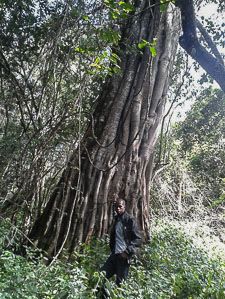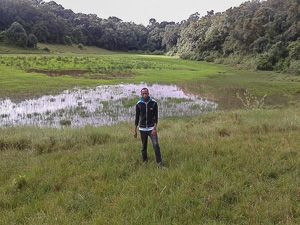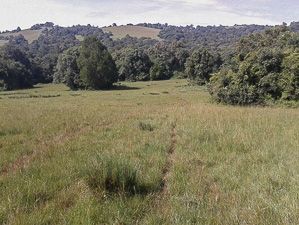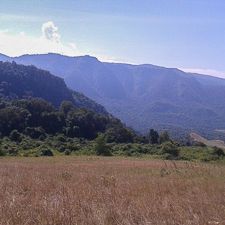

The area of land popularly known as Loita lies in southern Kenya between the Ngurman-Magadi escarpment and the Maasai Mara National Game Reserve. It covers an area of 1,700 km2 within the Loita Division of the Narok District. Loita is comprised of extensive semi-arid grasslands to the west, while the 330 km2 Loita Naimina Enkiyio Forest runs from north to south along its eastern border.
The Naimina Enkiyio Forest covers part of the land used by my community, whose ancestral lands straddle the border with Tanzania. It is one of the few non-gazetted trust land containing indigenous forests in Kenya. Naimina Enkiyio is an upland forest with the plains of Maasai Mara lying to the west and the Great Rift Valley to the east. It is one of Kenya’s few remaining, traditionally managed, indigenous forests, and it remains largely undisturbed. The forest is a unique and rich highland ecosystem that contains a large variety of plant and animal species, including numerous rare birds. There are many glades and natural water catchment areas, providing the Loita community with water and pasture, even during the dry season. The forest is dominated by the following tree species: Podocarpus latifolius, Cassipourea malosana, Olea capensis, Olea africana, Pavelta gardeniifolia, Podocarpus falcatus, Juniperus procera, Zanthaxylum usambarensis, Diospyros abyssinica, Teelea nabilis and Warbugia ugandensis. On the hilltops, the afromontane dry conifer habitat is dominated by the African pencil tree.
The forest has great cultural and spiritual value to the local communities, especially for my people, the Loita Maasai. We have no alternative but to live with our forest and other natural resources, and, subsequently, we have a large stake in its sustainable management. Our land is still communally owned trust land under the trusteeship of the Narok County Council, and while the forest has been reasonably well-protected to date, pressure is increasing as the demand for forest products rises due to growth in both human and livestock populations. There are, of course, other, less honorable factors that are harming our forest.
I was born right next to the Naimina Enkiyio Forest. As my mother told me, I came into the world in her house in the midst of hectic shouting: “Hold here, lift there, push hard!” And, with a midwife in attendance, my umbilical cord was severed. “You’re now responsible for your life, as I am responsible for mine,” she pronounced to me. Marking my separation from my mother, this symbolic utterance invited me into the harsh environment, so different from the softness and warmth of the womb. I was cleaned with a mixture of water and milk. My father was told immediately that he had a son, and the midwife told him to draw blood from the jugular vein of a bullock. He then mixed a drink for my mother by mixing its blood with warm milk. Someone then slaughtered a ram, known as olkipoket (house purifier), and the women who had brought milk to my mother as a present gathered inside our home and consumed the meat. Soon after, they sang a prayer to constitute a blessing to our house, my family, my mother and me.
The following day, the midwife gave my mother the melted fat from another recently slaughtered plump sheep to drink. The midwife was given the best cuts of meat from the rump. For three months, my mother breastfed me whenever I cried and, as I got older, her milk was supplemented with cow milk and ghee.
I was named when I was still very young. My mother and I had our heads shaved, and a lamb was slaughtered for my naming ceremony. During the ceremony, the elders and family women decide what name they will give to me, blessing it, “May that name dwell in you,” to which my mother replies, “Naaii” (yes, Lord). On the evening of the ceremony, my mother closed the entrance to the kraal (the cattle pen) by blocking it with sacred, green-leafed African olive branches from the forest, and later removed the branches from the entrance before the herds left to forage.
When I was very young, my sister cared for me while my mother went to collect firewood in the forest. My mother told me that they used to show affection to me by smiling and tickling me and raising me high up in the air the way Maasai warriors dance. When I started to walk, my mother held my hands to help me with my first step and sang:
Walk, walk, walk my little one,
Let us walk my little one
Slowly let us walk slowly
When I was a toddler, I was allowed to mingle freely with everyone in my family. At age four, I was encouraged to interact more with men. I started holding a stick from our forest to symbolize my future as a herder and learned how to herd cattle. As I grew up, singing became more and more important to me and, like other children, I loved to play. I used to construct miniature kraals out of damp soil and cow dung, and used pebbles inside them to represent livestock. Sometimes, I played hide-and-seek inside the thick vegetation of the forest with my sisters.
In the evening hours, my grandmother used to tell us exciting stories about the Naimina Enkiyio Forest. She told us how the forest got its name. Naimina Enkiyio Forest means the Forest of the Lost Child and is based on a Maasai legend about a young girl who was taking care of some calves when some of them got loose and wandered away. The girl went into the forest to find them, but the calves eventually returned home without her. Family members and warriors searched through the forest, but the girl was never found. Some believe that a monster grabbed her, dragged her to his hiding place and never let her go. Others believe giant, wild warriors cannibalized the girl. I think my grandmother and other elders were trying to scare us to keep us from going into the forest before we were old enough to know how to survive there.

At this age, I also had an opportunity to attend an emowoo olkiteng’ ceremony, which marks the beginning of a new age group and is usually conducted at a place known as Oloitokitok. This is when boys undergo initiations that begin their rights of passage as young adults. As a member of the new age set, I attended a ceremony to select a spiritual leader (known as olorip olasar) for our age group. The olorip olasar must spend a whole night awake, standing motionless under the sacred tree deep in the Naimina Enkiyio in the presence of an elder, an olpiron, who assists him.
In 2006, I completed primary school and told my father that I wanted to be circumcised, a sign of budding adulthood. My father announced my circumcision two months beforehand to give the family ample time to prepare, since there are articles that must be collected, such as ostrich feathers, honey and bees’ wax, and a special bullock that must be found for the day of the ceremony. My mother’s house, too, had to be repaired and made warm and cozy. Now that I was a boy who felt ready for initiation, I was prepared to meet every challenge.
Honey is the most important part of the preparations, since it is used to make beer for the elders and other guests at the ceremony. My parents requested that I bring honey from the forest, which was then mixed with water and certain roots from forest trees and poured into a large round calabash. It was placed near the fire and, with constant tending, the beer fermented after two weeks. Then we filtered it and divided it among many gourds for the special guests who had brought presents of cattle to us.
Three days before my circumcision, a group of special elders gathered together to drink some of the honey beer, leaving the rest of the beer for the actual day of the ceremony. On the next day, I had my head shaved and I gave away all of my belongings, since I must not retain any ornament or possession of my youth when becoming a man. On the same day, I was anointed with ghee and dressed in a garment of special hide cloth resembling that worn by women. I spent the day before the ceremony searching for a particular African olive tree sapling we call olatim. As a symbol of my new manhood, I planted this young tree on the day of my circumcision by the side of my mother’s house, where I was to stay after the operation.
In the early dawn on the day of the ceremony, I was teased by recently circumcised youth, who taunted me with evil words, such as, “Go and shame us, youth,” or “You’d better face it, it is blood that will flow, not milk.” As the rising sun struck the horns of the cattle, I was summoned to take my place at the main cattle gate. My mother gave me the hide of an unblemished ox — one that was slaughtered and did not die from disease — to sit on. I stripped naked, and my relatives washed me with cold water that had been kept outside overnight with an axe-head placed inside the container to make it even colder. This symbolic washing made my entrance into a whole new life by cleaning away all the wrongdoing I had committed during my past life as a youth. On a more practical level, it also numbed me somewhat for the operation.
An elder had already been selected to hold my back. I was circumcised in the center of the kraal in front of an audience of men and boys. When I was ready, the circumciser splashed my face with a chalky white mineral mixed with milk, which, in our culture, is often used as a blessing. As the chalky white mineral struck my head, the circumciser announced, “One cut!” What followed was a sharp knife. Then came the call to bring the milk of an unblemished cow whose calves are all living. With this call, the immense tension that had prevailed for two days and taken its toll during the operation subsided and people began to relax. I heard cries of praise from my mother, who had been collecting milk for washing the knife after the operation and had probably been thinking of hiding to avoid being beaten if I had been a coward. She said, “I knew he would make it through,” while others with humor said, “He is too ugly to be a coward.” As Maasai, we believe that one cannot be both ugly and a coward since God would not be so cruel as to give one person two bad things.
Then I was ordered, “Wake up, you are now a man.” I remained seated, waiting for my relatives to admire my bravery and to give me cattle and presents. They came up one by one and said, “Wake up so I can give you this animal.” When I had been given enough cattle to reward my patience and courage, my back supporter assisted me and slowly led me to my mother’s house, where I rested and nursed my wound. My family was proud because I was not declared a coward.
During the last month of my healing, after a successful, unflinching circumcision, I prepared a traditional colorful bird headdress for myself. I roamed widely, hunting and killing birds such as kingfishers, orioles and bee-eaters, as well as Diana’s barbets and lovebirds. Each bird I brought down I cleaned with ashes and dried grass, and then attached to a large, horseshoe-shaped crown. It can take up to 40 birds to complete such a headdress. Throughout this period, the piece was my prized possession, and I wore it during all ceremonies and dances. When my crown was completely filled with birds, I was shaved for the last time until I become an elder. As a young warrior, I moved into a different stage of life. I served for two months as an active warrior, or moran. Together with other young men, we went deep into the Naimina Enkiyio Forest to a place called Olasur, where we spent three weeks feasting on meat (cows, not wild animals) to convalesce, to restore our strength and, most importantly, to develop close bonds with my age mates.
Photos are copyright protected and may not be used without permission. All photos are courtesy of Alfred Mepukori
Want more? Read Part 2 here!
Photos are copyright protected and may not be used without permission. All photos are courtesy of Alfred Mepukori.